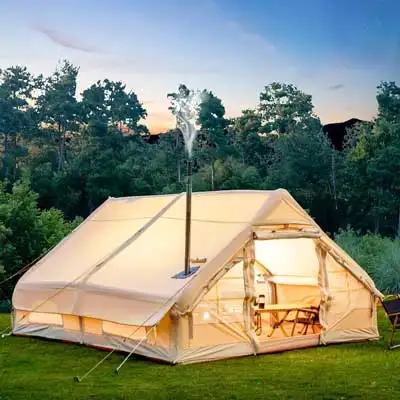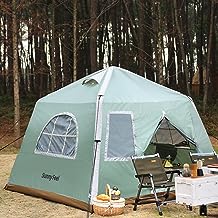10 tips for using an air tent safely, such as staking the tent down in windy conditions, preventing condensation, and keeping it clean and dry
Using an air tent can be a fantastic way to enjoy the great outdoors, but it’s essential to prioritize safety while camping. Here are ten tips that will help you use your air tent safely and ensure a pleasant camping experience.
First and foremost, always make sure to stake down your air tent properly, especially in windy conditions. Air tents rely on inflatable beams instead of traditional poles, which makes them more susceptible to being blown away in strong gusts of wind.

To prevent any mishaps, use sturdy stakes designed for air tents and securely anchor each corner of the tent. Additionally, consider using guylines or additional tie-downs for extra stability.
Another crucial safety measure is preventing condensation buildup inside the tent. Condensation occurs when warm air inside the tent comes into contact with the cooler tent fabric.
To minimize this issue, ensure proper ventilation by opening vents or windows whenever possible. It’s also helpful to avoid cooking inside the tent as it increases moisture levels.
By keeping airflow high and reducing humidity levels within the tent, you can prevent condensation issues and maintain a dry and comfortable camping environment. Additionally, keeping your air tent clean and dry is vital for both safety and longevity.
Make it a habit to sweep out any debris from inside the tent regularly, as accumulated dirt or leaves can pose slip hazards or damage the floor material over time. If you encounter rain during your camping trip, be diligent about wiping down any wet surfaces before packing up your gear.
This practice not only prevents mildew growth but also ensures that you don’t carry excess moisture into storage. By following these tips – staking down your tent securely in windy conditions, preventing condensation buildup through proper ventilation, and keeping your shelter clean and dry – you’ll be well on your way to using an air tent safely during all of your camping adventures.
Examples of accidents that have happened when people have not used air tents safely
Accidents can happen when proper safety precautions are not taken while using air tents. One such incident involved a family who set up their air tent on uneven ground. The lack of a flat surface caused the tent to become unstable, and during the night, it collapsed, causing injuries to some of the occupants.
This unfortunate incident could have been avoided if they had checked and chosen a suitable location for pitching their tent. In another case, an adventurous group decided to set up their air tent in an area with dense vegetation and tall grass.
As they enjoyed their camping trip, they noticed a strange smell coming from outside the tent. Little did they know that some critters had taken shelter underneath their tent due to its proximity to the ground.
Unfortunately, one of them ended up being bitten by a venomous snake that was seeking shade under the tent during the hot weather. This incident serves as a potent reminder of the importance of inspecting the camping area thoroughly before setting up an air tent.
These examples highlight just how crucial it is to consider potential risks and hazards when using air tents. By being diligent and taking necessary precautions, campers can ensure their safety and enjoy a worry-free experience in nature’s embrace.
Advice from experts on how to avoid accidents when using air tents
One of the most crucial aspects of using an air tent safely is proper setup and maintenance. To shed light on this, we consulted with camping experts who shared their wisdom on avoiding accidents when using air tents. Firstly, it is essential to stake down your air tent properly, especially in windy conditions.
The experts emphasized the importance of using robust stakes and ensuring that they are securely anchored into the ground. They recommended placing stakes at all corners of the tent and along its sides to provide maximum stability.

Additionally, attaching guy lines from the tent to nearby trees or rocks can further enhance its stability during gusts of wind. Secondly, condensation can pose a challenge when camping in an air tent, particularly in humid or cold weather conditions.
To tackle this issue, our experts suggested proper ventilation as a key solution. Opening vents and windows can help create airflow within the tent and minimize condensation buildup.
Placing a small towel or absorbent material at the bottom of each window can also help collect any excess moisture and prevent it from seeping into your sleeping area. Furthermore, maintaining cleanliness and dryness inside your air tent is paramount for a safe camping experience.
Experts emphasized the importance of regularly sweeping out any dirt or debris that may accumulate on the floor. This not only prevents slip hazards but also helps preserve the integrity of your tent’s flooring material.
Additionally, keeping wet items outside or in a designated “wet” area will help prevent moisture from spreading throughout the tent, reducing the risk of slips and falls. By following these expert tips for setting up properly, managing condensation, and maintaining cleanliness inside your air tent, you will significantly reduce any potential accidents while enjoying your outdoor adventures safely
Conclusion
It is of utmost importance to prioritize safety when using an air tent. By following the 10 tips mentioned in this article, you can ensure a safe and enjoyable camping experience.
Remember to always stake down your tent securely, especially in windy conditions. Use the provided guylines and pegs to anchor your tent firmly to the ground, preventing it from being blown away.
Additionally, take precautions to prevent condensation inside the tent by properly ventilating it. Open windows and vents as needed to maintain airflow and reduce moisture buildup.
This will help keep you comfortable and prevent any potential health issues caused by excessive humidity. Make sure to keep your air tent clean and dry.
Regularly sweep out any dirt or debris that may have accumulated on the floor or walls. If packing up a wet tent after use, be sure to dry it thoroughly when you get home before storing it away.
This will help prolong its lifespan and prevent mold or mildew from developing. By implementing these safety tips into your camping routine with an air tent, you can enjoy outdoor adventures with peace of mind knowing that you have taken all necessary precautions for a safe camping experience.
Remember, camping with an air tent can be both exciting and fulfilling. Embrace the beauty of nature while appreciating the comfort and convenience provided by modern technology.
With proper care and attention to safety measures, you can create lasting memories without compromising on comfort or security. So go forth confidently into your next camping trip with an air tent, knowing that safety is on your side!
To see more outdoor items visit Acme Toy Company today!




